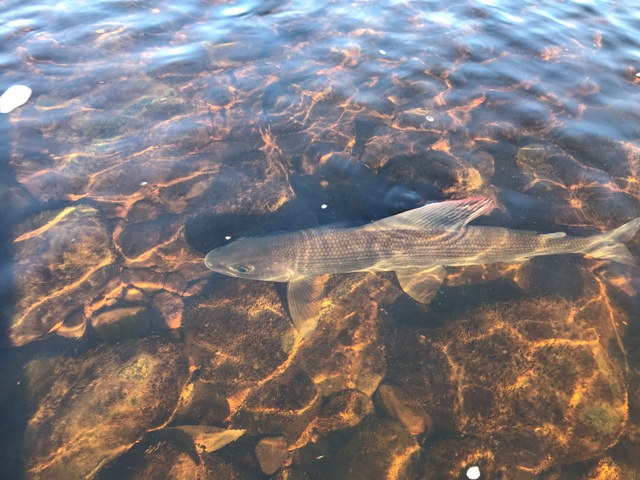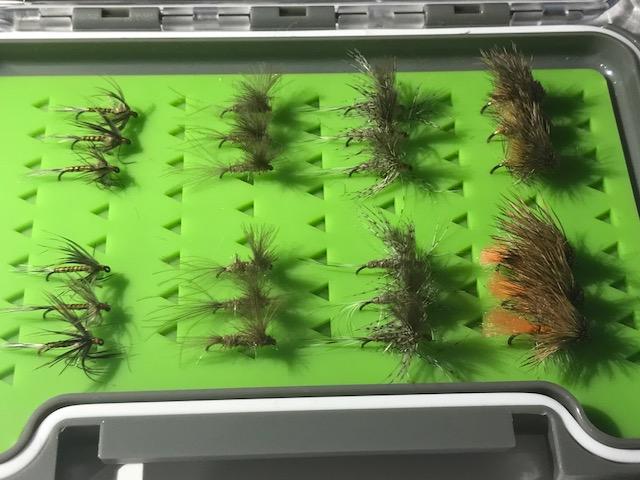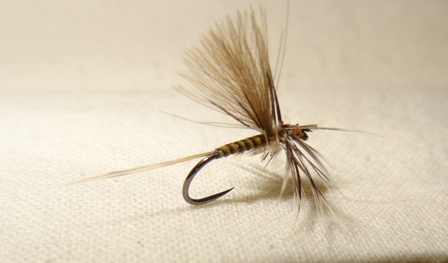| Back to Back Issues Page |
 |
|
Winter December 11, 2017 |
Winter
A new interesting book to help me through the winter months. I've caught grayling at - 7 Celsius so I have nothing to prove.
It is with great delight that that I can report a hunting kingfisher at Riverview, the home of Onstream-guide. It is the first I’ve seen since the demise of the resident kingfisher at the hands of a domestic tom cat last winter. I will follow the fate of this kingfisher through the winter months with great interest. The stream is full of snow melt and whereas fishing for us is recreational or competitive for a piscivore like a kingfisher, it is a matter of life or death and to be honest I wouldn’t fancy my chances in these conditions. Ecological balance and the health of the stream ecosystem are critical to survival of these beautiful specialists.
I was less pleased to see a large group of crows. It is not by chance the collective noun for crows (jays/magpies) is a murder. I remember as a young child of 5 or 6 driving around on my maternal grandfathers farm (named Fisher so it’s in the blood!) in the land Rover loaded shotgun in the back. Any crows were quickly dispatched (along with the rabbits) and hung from trees as a warning to other crows to stay away. The population and diversity of songbirds on his farm was greater than anywhere else in the area. He was a keen ornithologist and kept various linnets and finches as a hobby. He could name native birds based on the songs they produced. Shooting and managing the crow population he saw as essential for maintaining a safe environment for the smaller delightful songbirds. I have nothing personal against the crows but they are intelligent and adaptable and as far as songbirds are concerned an apex predator. He is a catholic feeder and will take everything from carrion to wrecking the nest and gobbling down songbird chicks. It makes sense that if this highly adaptable intelligent apex predator is left unchecked he will have a detrimental effect on everything underneath him in the food web. This was good conservation and land management in action in my opinion. I think conservation has to be pro-active and not laissez faire. The greatest dangers to our native fish feeders like heron and kingfishers are also other fish eating birds like gulls, cormorants and goosanders. Whereas heron and kingfishers undoubtedly improve the health of a fishery by removing the less able/diseased or injured fingerlings leaving the healthiest and strongest . This is Darwin’s “survival of the fittest in action”. Even Salmo trutta, the brown trout my favourite species has a 95% mortality rate in this fingerling stage. The greatest danger to a fingerling Salmo trutta is undoubtedly Salmo trutta himself. This apex predator in the stream is to some extent self limiting. The “invading birds” are not good for the environment and are indiscriminate taking healthy breeding sized fish. A 10 inch wild brown trout is literally one in a thousand. It has really seen life (in fish terms to reach that size). It is tough enough for trout without adding further dangers but I have great faith in this fantastically adaptable species to survive predation. Based on what I have observed in the Czech Republic it is grayling at greatest risk. I heard tales that the grayling where so thick you could walk across on their backs on the Otava River. They are now for practical purposes a rare species because of cormorant predation. Grayling are extremely fecund and fill the river with food for kingfishers and heron. If predation of healthy breeding sized fished by cormorants is allowed unchecked then the whole ecosystem will be damaged. Even from an ornithological conservation point of view it makes sense to control or remove these birds. From our point of view as river fly fishers it has huge implications if inland cormorant predation on small streams and rivers continues unchecked. 
I was extremely pleased to participate with Fred Bainbridge in a demonstration on Grayling techniques for Bradford and City Anglers on a stretch of the Upper Aire. Importantly the club have improved the river habitat by adding groins, and substantial planting of Alders along the bank. This is a perfect example of pro-active conservation. The grayling day was successful with fish coming to dry fly and nymphs. This was undoubtedly the best fish of the day a stunning 2lb plus grayling caught by visiting French angler Thomas Gatchet. I also participated in (and won) the club’s Annual Grayling Competition, the Arthur Scaife Memorial Trophy. I also fished with Thomas in the competition and he is a superb nymph fisher. But grayling being contrary as they are, at near zero degrees in a viciously biting Northerly wind preferred my dry flies to his superbly presented small nymphs. This is a 40 cm fish regaining her composure in the shallows, the largest fish I landed. 
Grayling fishing continues through the Winter months but my advice is to pick the softer days. I have a new fly fishing book to keep me occupied as well! A fly like the soft hackle dry I have great faith in because it acts as a living insect. It can also be twitched to mimic movement of natural hatching insects. In celebration of this and the festive season I have put together a one off special “living Fly box”. It includes the plover spider, half dozen alive soft olives, a half dozen soft hackle dry flies. Finally it includes a half dozen caddis patterns, the fly Leonard M. Wright junior was referring to in the opening passages of his book. This is a one off offer to e-zine subscribers and is limited for £40 plus £2.50 p & p. A great Christmas gift and perfect for the start of the new trout season 2018. The flies imitate perfectly those first to appear on UK streams. To qualify for the Offer leave a message with “living fly box” on the website and I will send an invoice for £42.50. 
I hope the Winter is kind for your grayling fishing, Regards, Jonathan. |
| Back to Back Issues Page |
